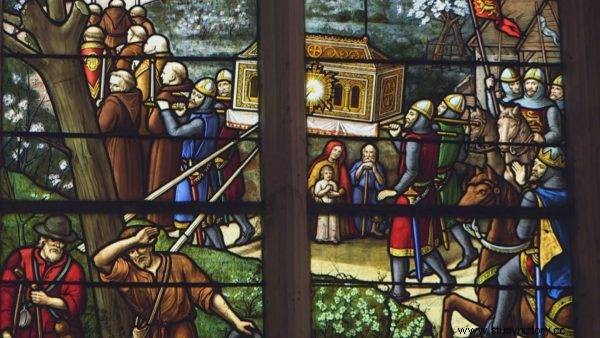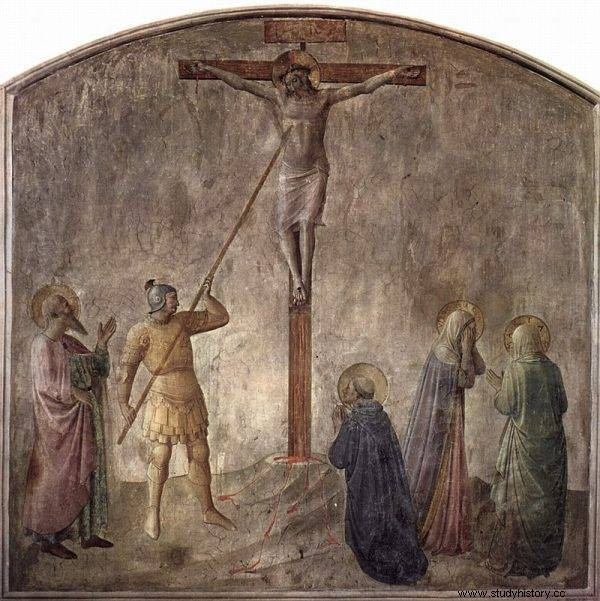“The plunder was not over yet when Alaric put on his beautiful robes and sat on the imperial throne. He put a golden crown on his head and took in his hand the Holy Spear with which Christ was pierced, ”wrote the Byzantine historian Procopius of Caesarea. The first Germanic conqueror of Rome firmly believed in the supernatural power of this particular relic. However, he was not the only one who wanted a powerful artifact ...
The biblical world has always fascinated (and continues to fascinate) mankind - regardless of belief or worldview. Numerous excavations carried out in the Holy Land, Egypt and other countries of the Middle East are intended to help in learning and understanding the stories written in the Bible.
Historians and archaeologists treat some fragments of the "book of books" as a loose record. Especially since they find no way to verify what is true and what is fiction. It would certainly be easier if they could find artifacts that were silent witnesses to the momentous events of early Christianity. Some of them - such as the Dead Sea Scrolls - have been able to bring new life back to life. However, many of the others will probably never see the light of day again. Here's what we know about them.
Ark of the Covenant
"The Lord spoke to Moses:" Tell the Israelites ... and they will make an ark of acacia wood; its length will be two and a half cubits; it is a cubit and a half high and it is a cubit and a half wide. And overlay it with pure gold, inside and out, and make golden wreaths around it ”(Ex 25, 1-2, 10-11).
The box described in detail was to be a shelter for the tablets with the Ten Commandments. According to the Bible, the Ark had unspeakable, even otherworldly power. The unfortunate one who wanted to touch her would have died on the spot. But thanks to her presence, the Israelites became invincible, walking from victory to victory.
They carried it with them during 40 years of wandering in the desert. After the conquest of Canaan, however, the artifact was taken to Shiloh. Later King David took the Ark to Jerusalem, where his son and successor Solomon finally found a worthy place for it in a great temple built by him. It was kept there until 587 B.C.E., when the holy city fell to the Babylonians.

Every now and then there are reports of the Ark of the Covenant being found, but so far none have been real.
The invaders demolished the temple, taking from it various "valuable items". Was the Ark of the Covenant among them? Some scholars believe that the Babylonians, insensitive to the spiritual value of the relic, simply destroyed it. However, some experts believe that at the last minute the Israelites managed to save this peculiar national treasure . According to various hypotheses, it was to end up in Mecca or be hidden by the prophet Jeremiah in a grotto on Mount Nebo. There are also those who believe that the artifact has found shelter in the Church of Saint Mary of Zion in Aksum, Ethiopia.
There are probably as many ideas and theses about the location of the Ark of the Covenant as there are many scientists and enthusiasts dealing with this topic. And although the news of its discovery spreads around the world every now and then (such as the revelations of Prof. Tudor Parfitt, pseudo-archaeologist Ron Wyatt or Prof. Edward Ullendorff), probably - as some say - "she will not appear until the coming of the Messiah."
Holy Grail
Traditionally, the Holy Grail is considered to be the chalice that Christ used at the Last Supper. Joseph of Arimathea was to collect the blood of the crucified Jesus into the same vessel. From ancient legends to modern movies, the Holy Grail has been a fascination for centuries.
If he did exist, then after the Messiah's death on the cross, his trace was virtually lost. He experienced a kind of renaissance in the Middle Ages, but not because of some spectacular discovery. The Holy Chalice became a popular topic in literature, and stories about him were read and recited all over Europe . Some Arthurian tales said that Joseph of Arimathea brought the Grail to Glastonbury, England. Legend also has it that where the chalice is buried, the water is red because it flows through the blood of Christ. However, scientists have proved that the color is due to the presence of iron oxide.
King Arthur himself was supposed to organize great expeditions in search of a mysterious relic. And there was something to strive for, because according to rumors the holy cup had the power to heal all wounds, ensure eternal youth and happiness - so it fulfilled the eternal desires of humanity.

The Holy Grail is an important part of Arthurian legends
Researchers of the topic suspect that the Holy Grail may have fallen into the hands of the most powerful knightly order of the Middle Ages - the Templars. Knights with a red cross on their cloaks received from King Baldwin II a part of the royal palace in Jerusalem, near the al-Aqsa mosque, the former temple of Solomon. According to legends and reports of witnesses, they were supposed to find a miraculous vessel there and hide it again from the world in anticipation of calmer and more dignified times. These, however, never came for the Templars, and with their fall, the chance to find the relics was lost.
Or so it might seem. Recently, Spanish historians announced that they had found the Grail in a church in León in northern Spain. Moreover, they stated that the goblet had been stored there since the 11th century. Dating confirmed its creation between 200 BCE. and 100 C.E., the period in which Christ lived and died.
The world of science, however, is not entirely convinced of the authenticity of the Spanish find, especially since there are about 200 alleged chalices in the world - witnesses of the Last Supper . The Holy Grail is still the object of the sighs of artifact hunters and artists, for whom the most sacred vessel of Christianity even took the form of ... the womb of Mary Magdalene. But that's another story.
Source Q
Source Q is the name given by scholars to a hypothetical text that was to be used by Matthew and Luke when writing their Gospels. The fact that the search for the mysterious source is still ongoing prompts some scholars to speculate. It is believed that the evangelists were based not only on the Gospel of Mark, but also on the unwritten oral tradition.

Did the authors of the Gospels of Matthew and Luke use any source other than the Gospel of Mark?
Whatever it was, attempts are still being made to reconstruct the text. According to some researchers, it was a collection of Christ's statements, i.e. logos (taken out of the context of quotes from the Messiah, such as maxims, instructions or parables) . The Coptic Gospel of St. Tomasz, which confirmed the existence of such a literary genre. According to biblical scholars, the source of Q could have approximately 240 verses, and Jesus' words were to be arranged in a similar order to that found in the Gospel of Luke.
If the source of Q did exist, it probably wasn't widely distributed. Was it a deliberate act or a complete accident? It is not known.
Spear of Destiny
Jesus, dying on the cross, was stabbed with a spear by the Roman centurion Gaius Cassius. When a drop of Christ's blood fell into his eye, she miraculously cured him of the cataract. As a result, he truly saw his eyesight, quit legionary service and converted to Christianity, taking the name Longinus. With a bloodied spear, he traveled the Roman Empire for 28 years, preaching the Gospel. After his martyrdom, all information about this weapon was lost.
The Spear of Longinus very quickly acquired the status of a relic, and the legends appearing about it rival those of the Holy Grail or the Ark of the Covenant. Probably the fact of using it to pierce Christ's side meant that it was attributed to it, like other artifacts belonging to the so-called arma Christi (relics associated with the Passion), miraculous properties . The fragments of the cross were to protect against evil, the Messiah's robe was to heal and resurrect, and the said spear was to provide power over the world.
Therefore whoever possessed the Longinus weapon became invincible, all-powerful; could decide the fate of mankind. No wonder the Roman centurion's spear was dubbed the Spear of Destiny.

Longinus piercing the side of the deceased on the cross of Jesus Christ with a spear
According to tradition, the history of the spear was extremely turbulent. It is believed that around 290 a Roman officer in Mauritius (now known as Maurice) became the owner of the relics. He, too, died a martyr's death, and the Christians, having recognized him as a saint, named him a spear after him. Later, it was to fall into the hands of Constantine the Great - and help him fight for the imperial title. It passed through the hands of successive Roman rulers, to leave the walls of the Eternal City in the 5th century, thanks to the Visigoth king Alaric.
Since then, the artifact has changed hands like gloves. The ruler of the Franks, Charles the Hammer, had it with him in the victorious battle of the Saracens at Poitiers in 732. St. Maurice successfully accompanied Charlemagne in all his wars. Then for almost 1000 years she became a symbol of the power of German monarchs. It was at this time that Emperor Otto III handed over a copy of the holy weapon in Gniezno to Bolesław the Brave (this relic is still kept at Wawel).
The original (or so it was believed) belonged to the successors of the imperial title until it was taken over by the occult-obsessed Adolf Hitler. The Führer was convinced that the Sancta et Crucifera Imperialis Lancae it will allow him to rebuild the great German empire and gain absolute power over the world.
Nothing came of Adolf's plans, and the holy lance fell into the hands of the Americans. The Yankees, however, did not have such special feelings for the relics as the Europeans and handed it over to Austria. There, in the Hofburg Palace Museum, she finally found an asylum worthy of her rank. Some, however, argue that this is just a replica intended to deceive the Allies. The original, however, still lies somewhere hidden by the Nazis. The search and research continues.
Document "The Secret of the Spear of Destiny" , to watch on the Polsat Viasat History HD channel. The premiere on Monday, December 14, at 20:45
